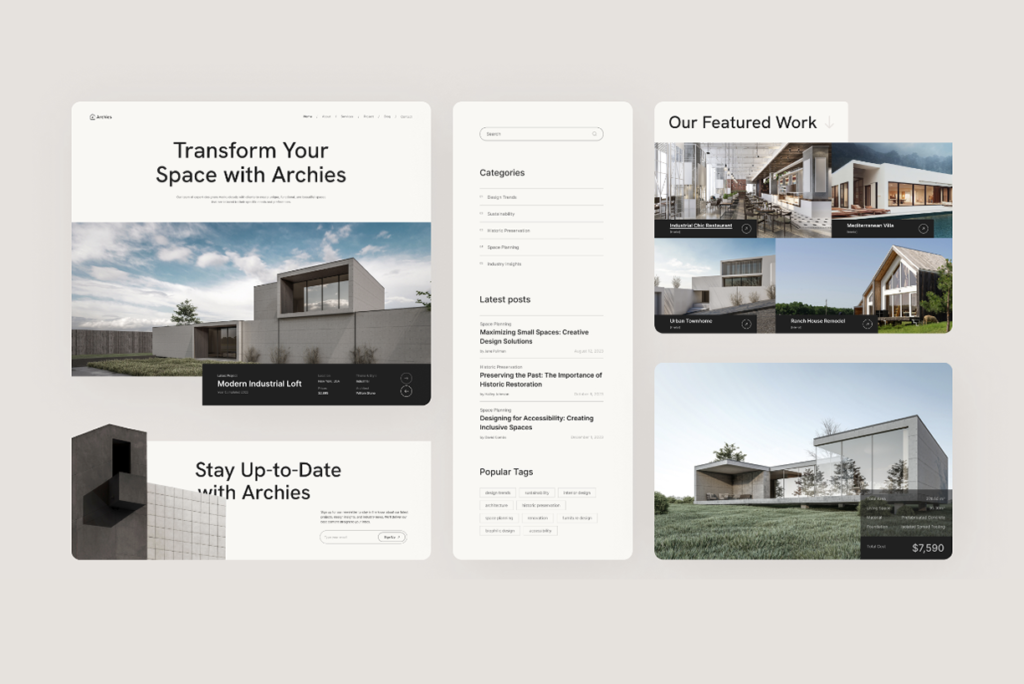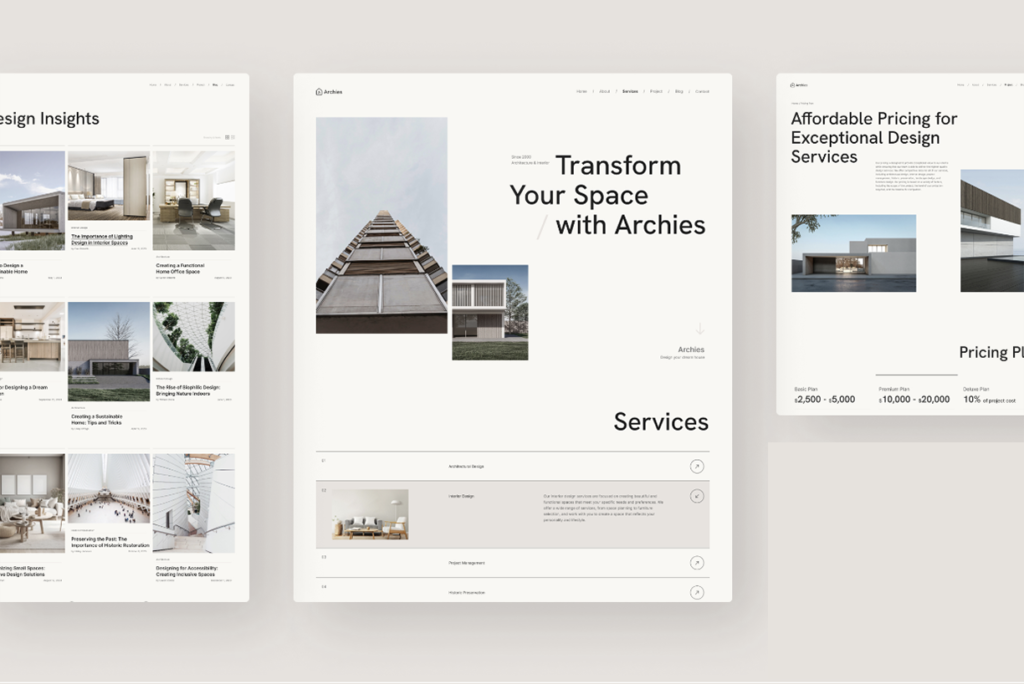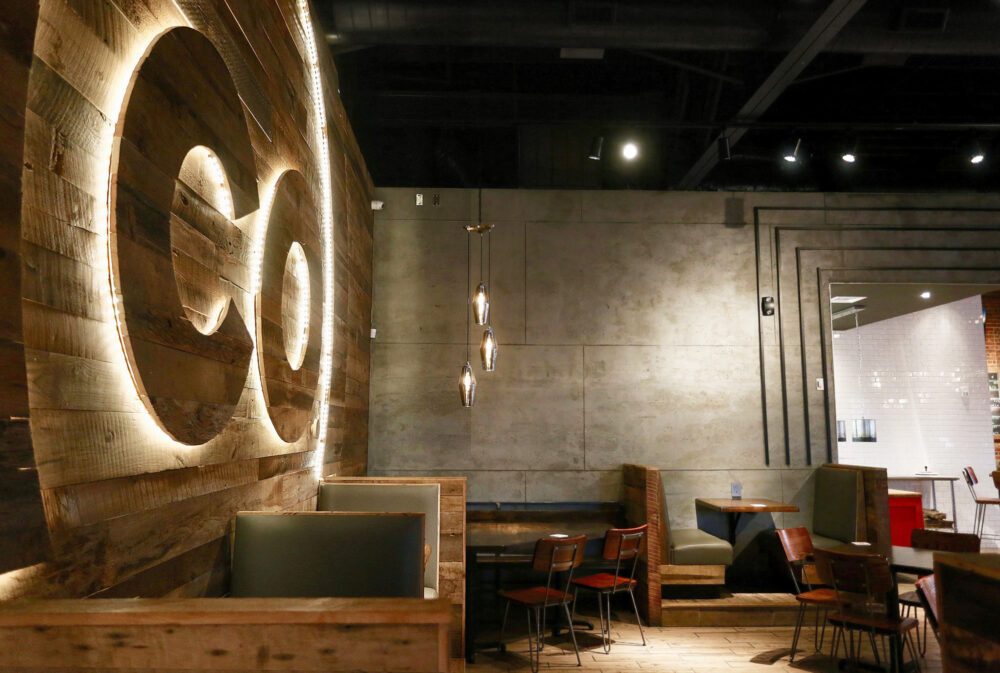There are many parallels between designing commercial environments and designing a website. Without proper blueprints to build a foundation from, both experiences can become misguided, uninspiring, and over-budget.
Architects and engineers have a unique advantage when engaging their audience online that many other services do not; they can over-zealously show off, and viewers expect it.
In today’s landscape, architects are no longer limited to designing physical spaces alone. An architect’s online presence is as equally important as their physical portfolio. A well-designed website is a powerful tool that can showcase work, attract potential clients, and reinforce trust in a firm’s abilities and people even before a conversation can be had. One of the critical aspects of a successful architecture website is just that, architecture. In this article, we’ll delve into how information should be layered, how work should be shown, and how users should efficiently navigate the experience.
Like professionals in many creative fields, architects often rely heavily on referrals or what could be described as “hope marketing.” In the world of architecture, this term refers to the practice of showcasing visionary designs with the hope that potential clients or collaborators will be captivated by the work and engage directly based on the assumed abilities of the firm or an experience in previously working with them in the case of a referral.
However, the online experience can be underestimated in its influence to capitalize on the hope and it ability to open up more deliberate opportunities. Prospects outside the referral network now look to strong portfolios, transparency in people, style compatibility, and online reviews considering professionals in architecture for a new project.
In a landscape as competitive as architecture, it’s essential to have a website strategy that promotes the firm values, builds a report with prospects, functions efficiently, and builds trust in its people, talent, and experience. Here are some key considerations why a well-made website is essential in the architecture industry:
First Impressions Matter: This is your first date with viewers. Just like a well-designed space can leave a lasting impression, a visually appropriate and stunning website can make a memorable experience; and one that users want to return to. Your website is often the first exposure people have with a broad display of your work and glimpse into the people behind it.
This initial visit can also be quick and decisive, either positively or negatively. We all consume content at light speed these days and due to social media trends, we also love eye candy. For example, ecommerce page view times can range from 44 seconds to 1 minute and 22 seconds. While blog posts can range between 2 to 5 minutes. So building an online experience that is immediately visually impactful, engaging, and thought-provoking is key.
Showcasing Your Portfolio: An architect’s site and portfolio are the most significant opportunities to showcase work; they can give viewers not just fantastic imagery but a wholesale view of projects wall to wall and how you, as the architect, arrived at the result you did. High-quality images, video walk-throughs, and interactive galleries can help potential clients get a strong feel for what you can do for them.
Build a Blog: As stated above, article and blog readers stay on a site significantly longer than other sections, increasing the odds of retention and contact. Through articles and blog posts hosted on your site, architects can showcase their expertise and thought leadership, positioning themselves as industry authorities. Posting this content on social platforms and industry sites can also play a significant role in driving organic traffic back to your site and portfolio. Moreover, writing articles fosters a culture of continuous learning and reflection. It encourages architects to stay updated with the latest trends, materials, and technologies, enhancing their ability to deliver successful designs.
Make it Move: Including video and virtual content plays a pivotal role in the attractiveness and relatability of architectural work in a website portfolio. These mediums allow architects to convey their work in a highly immersive and engaging manner. By creating virtual walkthroughs, flyovers, or 3D renderings, architects can offer a more vivid and realistic representation of their projects, allowing clients to understand better and visualize the outcome.
Mobile Responsiveness: With just over 50% of all web traffic coming from mobile, your site must provide a seamless responsive experience across various devices and screen sizes. A responsive design adapts your website’s layout and content to fit the user’s device, ensuring that your work looks impressive, regardless of how it’s accessed. While most vetting architecture firms will eventually engage on a desktop to get the best possible idea of the work, it is vital to account for all scenarios.
Speed and Performance: Just as architectural plans need to be executed efficiently, your website should load quickly and perform smoothly. Slow-loading websites frustrate users and can lead to high bounce rates. Optimizing the speed and performance of your website not only enhances the user experience but also boosts your search engine rankings, making it easier for potential clients to find you online.
Building Trust and Credibility: Trust is crucial in architecture; clients rely on your expertise to bring their visions to life. A stable and properly functioning website focusing on UX builds trust by demonstrating your commitment to professionalism and attention to detail. Remember, viewers will draw conclusions about you on the site, so if there are broken links, non-working features, out-of-resolution imagery, or grammatical errors, a user can and often will associate the experience of working with you with similar chaotic outcomes.
Accessibility Matters: Accessibility is not only a legal requirement in many regions but also a moral obligation. Ensuring that your website is accessible to all users, including those with disabilities, not only broadens your potential client base but also showcases your commitment to inclusivity and social responsibility; all considerations when designing a space as well.
SEO: SEO is always essential; however, it can allow architects to build a generous amount of references to project features and locations when displaying vast amounts of work. This ensures that potential clients can be attracted to specifically what services or styles they want in an architect.
Conclusion.
If you are an architect, treat your site as a new build or renovation project. Listen to your audience, develop plans, be creative, think about usability, and make these experiences as sustainable and accessible as possible.





